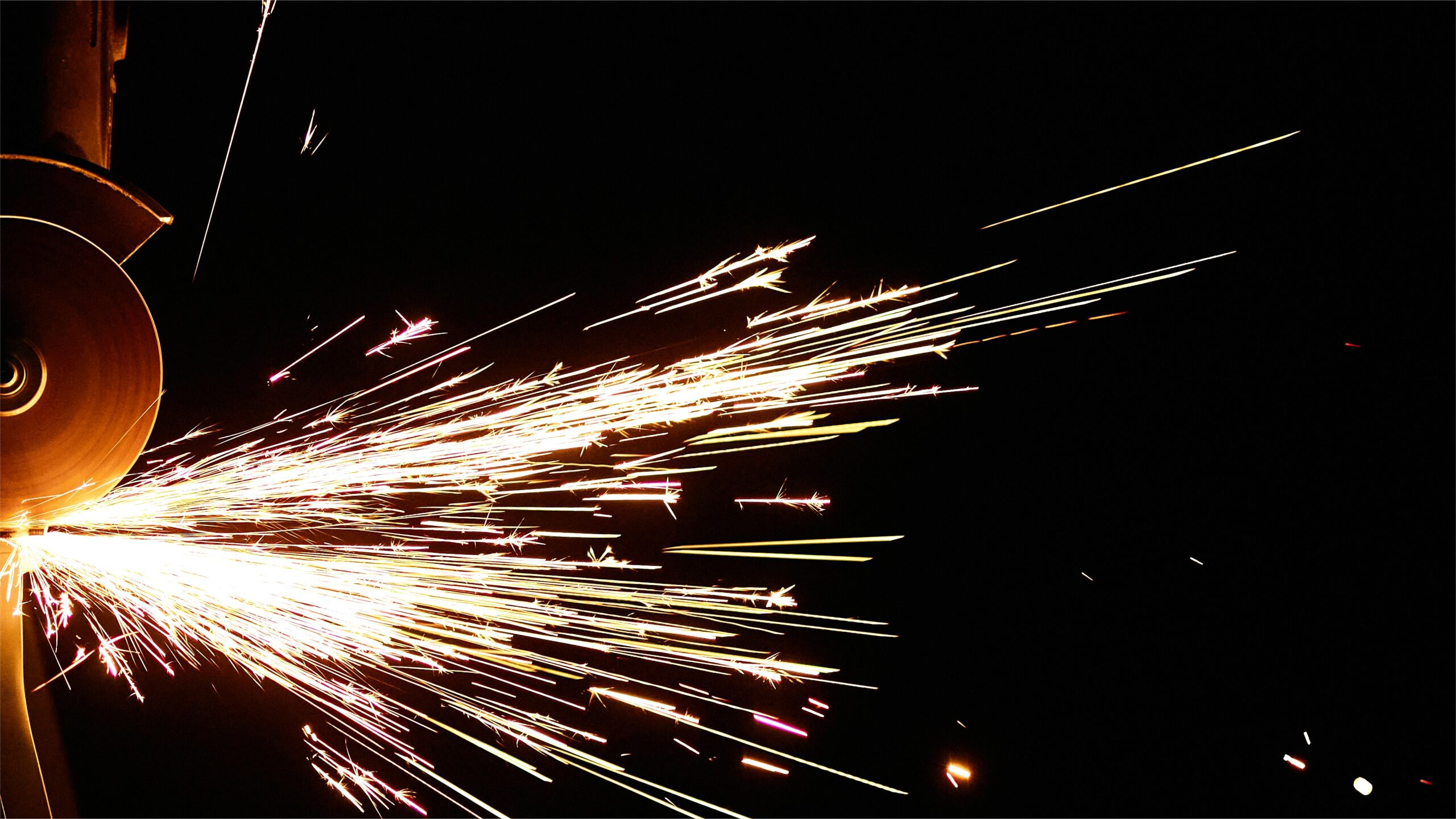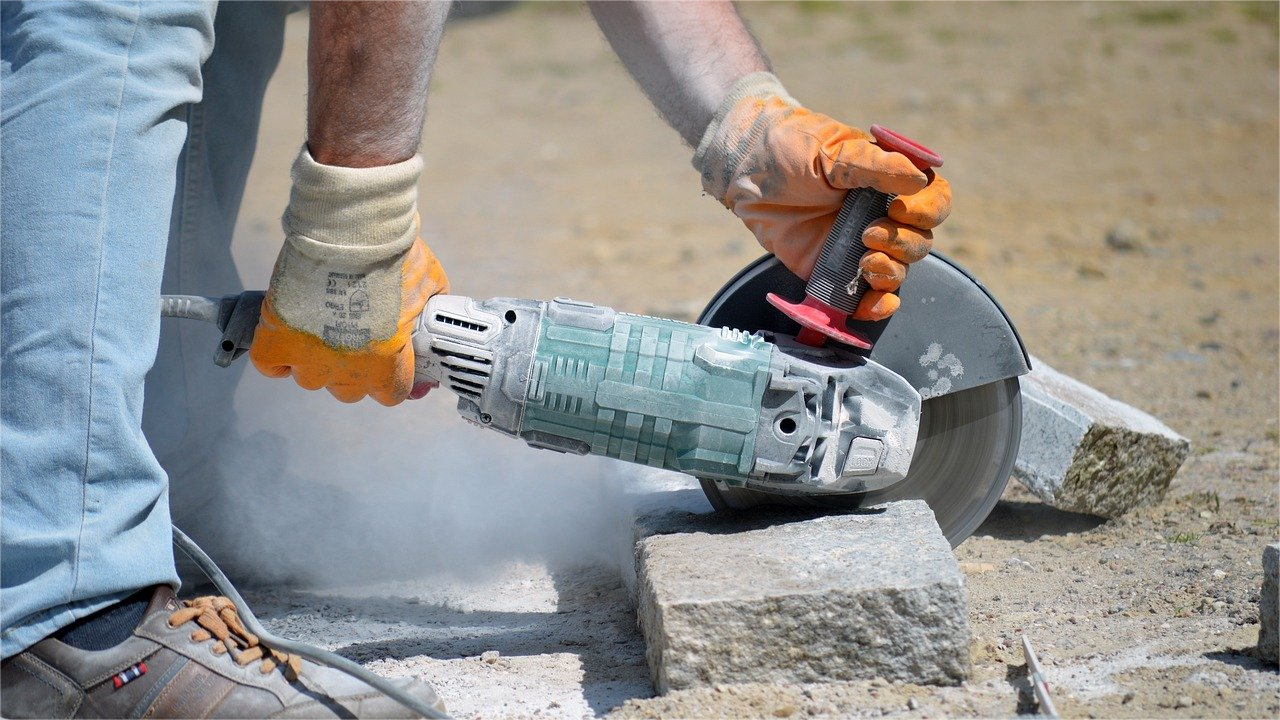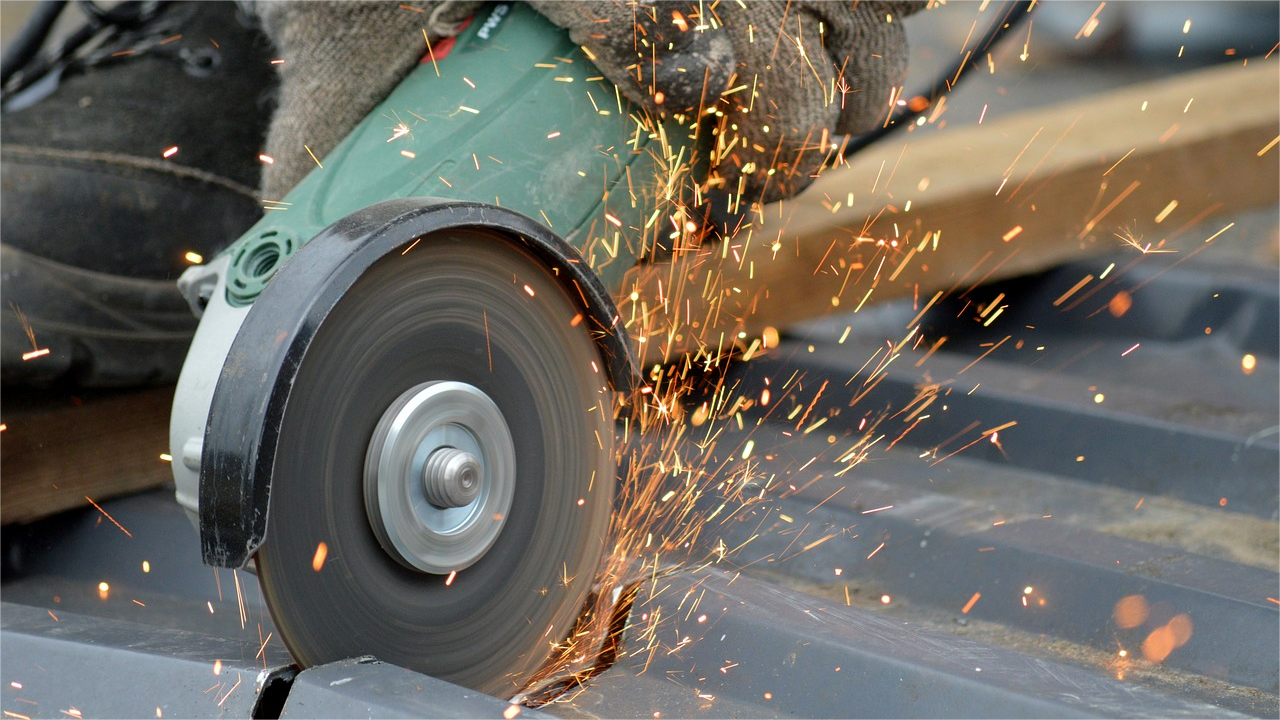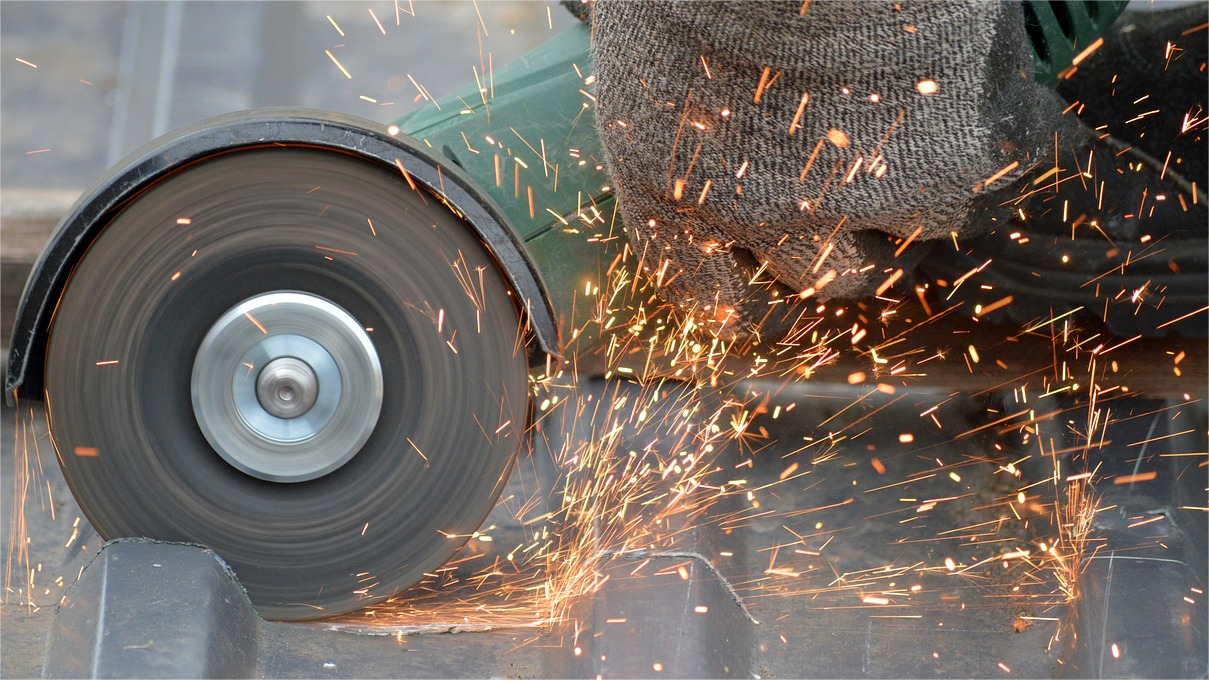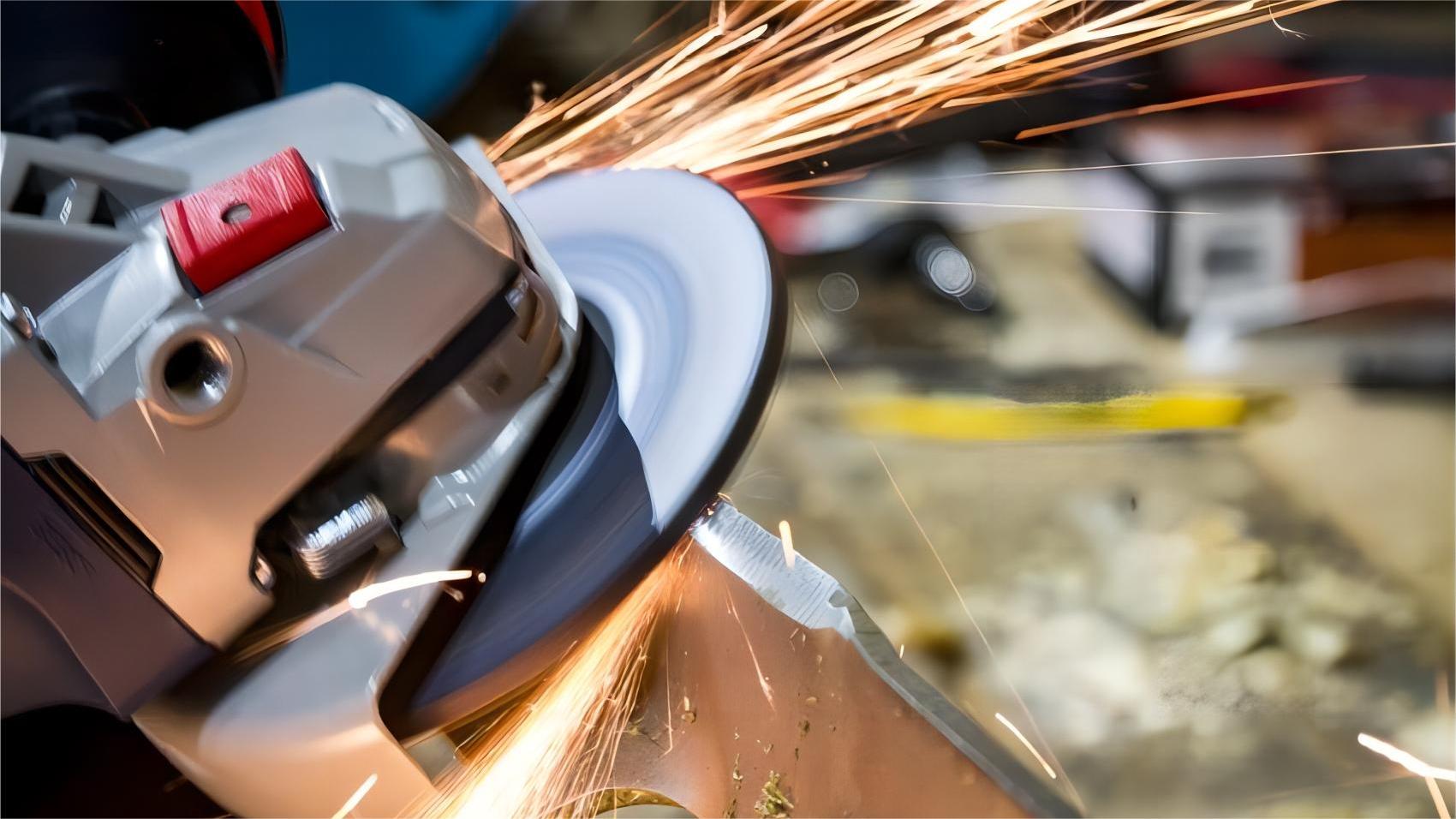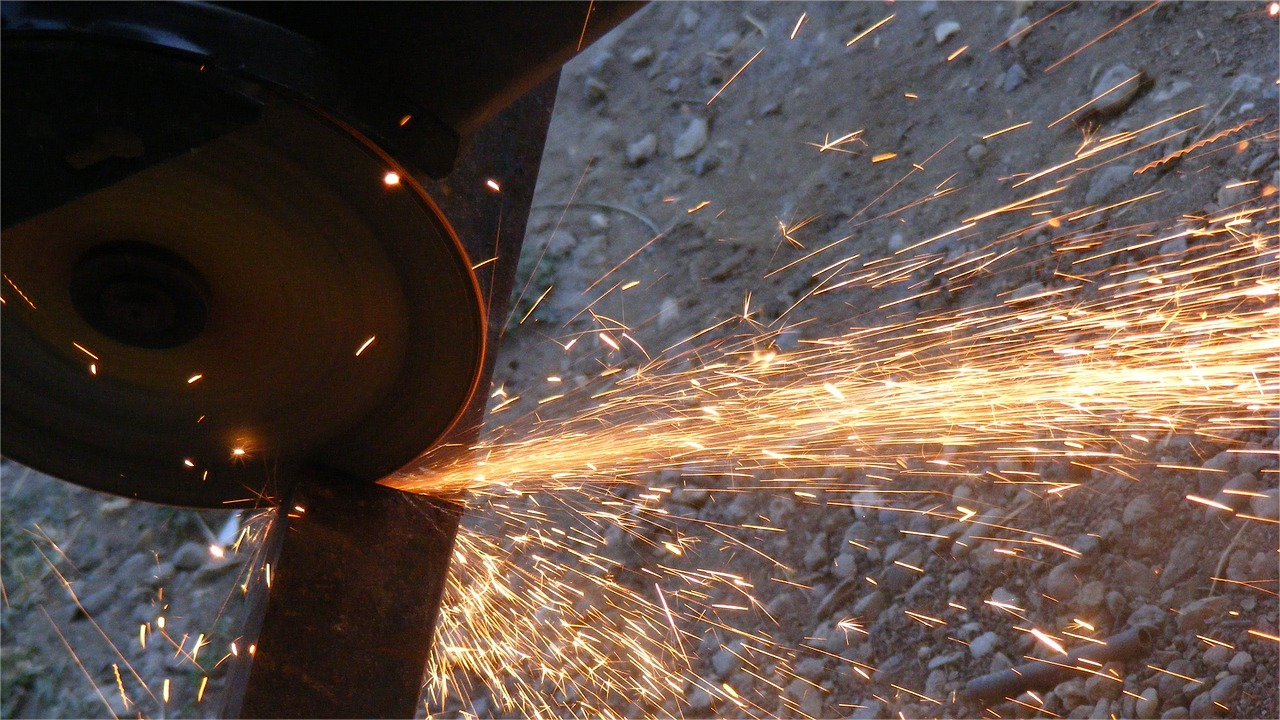Angle grinders, the unsung heroes of various industries, are versatile tools that have revolutionized the way we cut, grind, and polish materials. These handheld power tools have become indispensable, offering a wide range of applications across different sectors.
History of Angle Grinder
Angle grinders, those indispensable tools in workshops and construction sites, have a fascinating history that traces back to the mid-20th century. Developed to address specific needs in metalworking and construction, these handheld powerhouses have evolved significantly over the years.
The Birth of the Angle Grinder
The concept of the angle grinder can be attributed to the German company Ackermann + Schmitt, which introduced the “Flex” in 1954. This pioneering tool was a breakthrough in the world of power tools, featuring a handheld design and a gear-driven mechanism that allowed for versatile use.
Early Applications
Initially designed for grinding and polishing operations, early angle grinders were primarily used in metal fabrication. The ability to maneuver the tool easily and access tight spaces made it a game-changer in industries where precision was paramount.
Evolution of Design
As the demand for more versatile tools grew, manufacturers started refining the design of angle grinders. The introduction of adjustable guards, auxiliary handles, and ergonomic features improved user comfort and safety. These enhancements broadened the scope of applications beyond metalworking.
Transition to Electric Power
In the early years, angle grinders were often powered by compressed air, limiting their portability. However, with advancements in electric motor technology, electric angle grinders gained popularity for their convenience and ease of use. This transition marked a significant milestone in the tool’s evolution.
The Rise of Battery-Powered Angle Grinders
In recent decades, the advent of lithium-ion battery technology revolutionized the power tool industry, including angle grinders. Battery-powered angle grinders became a game-changer, providing the mobility and flexibility needed in various construction and DIY projects.
Applications Across Industries
The versatility of angle grinders expanded their applications across multiple industries. From construction and metalworking to woodworking and even art, these tools became essential for professionals and hobbyists alike.
Safety Innovations
With the increasing use of angle grinders, safety became a paramount concern. Manufacturers responded by integrating safety features such as kickback reduction, electronic braking systems, and improved guard designs. These innovations aimed to mitigate potential hazards associated with the tool’s powerful nature.
Technological Advancements
In recent years, angle grinders have undergone further technological advancements. Smart features, such as electronic speed control and overload protection, have become common, enhancing user control and prolonging the tool’s lifespan.
The history of angle grinders is a tale of innovation, adaptability, and evolution. From its humble beginnings as a metalworking tool to its widespread use across various industries, the angle grinder continues to play a crucial role in shaping materials and projects around the world.
Types of Angle Grinders
Angle grinders are indispensable tools that come in various types, each tailored to specific needs and preferences. Understanding the different types of angle grinders is crucial for selecting the right tool for the job. Let’s delve into the three main categories: electric, battery-powered, and pneumatic angle grinders.
Electric Angle Grinders
Electric angle grinders are the most common and widely used type. They are powered by electricity and are available in a range of sizes and power ratings. These grinders are ideal for both DIY enthusiasts and professionals due to their consistent power output and reliability.
Key Features:
Consistent Power:
Electric angle grinders provide a stable and reliable power source, ensuring consistent performance during various tasks.
Versatility:
Available in different sizes, electric angle grinders can handle a wide range of applications, from light to heavy-duty tasks.
Ease of Use:
Simply plug into a power source, and you’re ready to go. This makes them convenient for a variety of settings.
Considerations:
Corded Nature:
The need for a power outlet limits mobility. However, extension cords can mitigate this limitation.
Battery-Powered Angle Grinders
As technology advanced, the introduction of battery-powered angle grinders addressed the mobility issue associated with electric grinders. These cordless tools run on rechargeable lithium-ion batteries, providing users with the freedom to move around without being tethered to a power source.
Key Features:
Portability:
Battery-powered angle grinders offer unparalleled mobility, making them ideal for jobs in remote locations or areas without easy access to power outlets.
Convenience:
No cords mean no tangling or limitations. Users can easily carry these grinders to different job sites.
Powerful Performance:
Modern lithium-ion batteries deliver impressive power, allowing cordless angle grinders to compete with their corded counterparts.
Considerations:
Battery Life:
Depending on the task, users may need to manage battery life effectively. Having spare batteries is advisable for longer projects.
Pneumatic Angle Grinders
Pneumatic angle grinders, also known as air-powered grinders, operate using compressed air. These grinders are favored in industrial settings where a compressed air system is readily available.
Key Features:
High Power Output:
Pneumatic grinders are known for their high power output, making them suitable for heavy-duty applications.
Cooler Operation:
Unlike electric grinders, pneumatic grinders tend to operate at a lower temperature, reducing the risk of overheating.
Durability:
With fewer internal components, pneumatic grinders often boast a longer lifespan and require less maintenance.
Considerations:
Air Supply Requirement:
These grinders rely on a compressed air source, limiting their use to environments with available air systems.
Initial Setup:
Setting up a pneumatic angle grinder involves connecting it to an air compressor, adding an initial step compared to electric and battery-powered counterparts.
In conclusion, the choice between electric, battery-powered, and pneumatic angle grinders depends on specific needs and preferences. Electric grinders offer consistent power, battery-powered ones provide unmatched mobility, and pneumatic grinders excel in heavy-duty applications. Consider the nature of your projects and the available resources to determine the most suitable type for your requirements. Each type has its strengths, making angle grinders versatile tools in the hands of users across various industries.
Choosing the Right Angle Grinder
Selecting the right angle grinder is crucial for achieving optimal results in various tasks. From metal cutting to polishing and grinding, the right tool can make a significant difference. Here’s a comprehensive guide on the key factors to consider when choosing an angle grinder.
Consideration of Power and Disc Size
Power:
One of the first considerations when choosing an angle grinder is the power it delivers. Power is typically measured in watts or amps. For lighter tasks, a lower-powered grinder may suffice, while heavy-duty applications demand higher wattage. Consider the nature of your projects and choose a grinder with sufficient power to meet your needs.
Disc Size:
The disc size of an angle grinder determines its versatility. Smaller discs, around 4 to 4.5 inches, are suitable for tasks that require precision, while larger discs, 7 inches or more, are better for heavy-duty applications. Choose the disc size based on the type of work you’ll be undertaking regularly.
RPM and Speed Settings
RPM (Revolutions Per Minute):
The RPM of an angle grinder indicates how fast the disc spins. Different tasks require different RPM settings. For example, higher RPM is suitable for cutting, while lower RPM is preferable for polishing. Check the grinder’s specifications and ensure it offers the necessary range of RPM for the tasks you plan to perform.
Speed Settings:
Many modern angle grinders come with variable speed settings. This feature allows you to adjust the speed based on the material you’re working on. For instance, lower speeds are suitable for working on softer materials, while higher speeds are ideal for tougher materials. Having this level of control enhances the precision and efficiency of your work.
Safety Features
Guard and Handle Design:
Safety is paramount when using angle grinders. Look for models with adjustable guards that can be positioned to shield against sparks and debris. Additionally, ergonomic handle designs contribute to better control and reduce fatigue during prolonged use.
Kickback Protection:
Kickback, a sudden and uncontrollable reaction of the grinder, can be hazardous. Some angle grinders are equipped with features that minimize kickback, enhancing user safety. Investing in a grinder with effective kickback protection is particularly important for beginners.
Overload Protection:
To prevent motor burnout, consider angle grinders with overload protection. This feature automatically shuts off the grinder when it senses excessive load, protecting both the tool and the user.
Spindle Lock:
Changing discs is a common part of angle grinder use. A spindle lock makes this process safer and more convenient by immobilizing the spindle, making disc changes quicker and easier.
Choosing the right angle grinder involves a thoughtful consideration of power, disc size, RPM, and safety features. It’s crucial to match the tool’s specifications with the demands of your projects. Whether you’re a DIY enthusiast or a professional, selecting the appropriate angle grinder enhances both efficiency and safety.
Applications of Angle grinders
Angle grinders, those powerful and versatile tools, have become essential in a myriad of applications across various industries. From metalworking to woodworking and beyond, these tools have proven their worth. Let’s explore the diverse applications that make angle grinders indispensable.
Metal Cutting and Grinding
One of the primary applications of angle grinders is in metal fabrication. Equipped with abrasive discs, angle grinders can effortlessly cut through metal sheets, pipes, and rods. The grinding function allows for the smoothing of rough edges and the shaping of metal pieces with precision.
Masonry Work
Angle grinders are invaluable in masonry projects. Whether it’s cutting bricks, tiles, or concrete, these tools excel in providing a clean and precise finish. The ability to switch between cutting and grinding modes makes angle grinders indispensable for tasks like tile installation or creating openings in concrete walls.
Woodworking
Woodworkers also benefit from the versatility of angle grinders. With the right attachments, these tools can carve, shape, and sand wood. From rough shaping to fine detailing, angle grinders provide woodworkers with a range of options, making them a valuable addition to any woodworking shop.
Polishing and Sanding
Angle grinders equipped with polishing and sanding attachments are adept at giving surfaces a smooth and finished look. Whether it’s polishing metal surfaces to a high shine or smoothing down rough wooden edges, these tools are essential for achieving a professional finish.
Welding Preparation
Before welding, it’s crucial to prepare the materials properly. Angle grinders are often used to clean and smooth weld joints, removing rust, paint, and other contaminants. This preparation ensures a strong and clean weld, contributing to the overall quality of the finished product.
Safety Gear Manufacturing
In safety gear manufacturing, precision and accuracy are paramount. Angle grinders are used to shape and refine the edges of safety gear components, ensuring a comfortable fit and optimal protection. The versatility of these tools plays a crucial role in producing high-quality safety equipment.
Automotive Repair and Restoration
Angle grinders find a place in automotive workshops for tasks such as cutting metal panels, smoothing welds, and preparing surfaces for painting. Their compact size and maneuverability make them ideal for intricate automotive repair and restoration work.
DIY Home Projects
From home renovations to crafting projects, angle grinders are a DIY enthusiast’s best friend. Whether it’s cutting tiles for a bathroom makeover or shaping metal for custom furniture, these tools empower homeowners to tackle a wide range of projects with efficiency and precision.
Sculpture and Art
Artists and sculptors embrace the versatility of angle grinders to create unique and intricate sculptures. The ability to carve and shape various materials opens up new possibilities in artistic expression, making angle grinders a valuable tool in the art world.
In conclusion, angle grinders are not just tools for specific industries—they are multi-purpose instruments that cater to the needs of metalworkers, woodworkers, artists, and DIY enthusiasts alike. The applications of angle grinders continue to expand as users discover new and creative ways to leverage the power and precision these tools provide.
Best Practices When Using Angle Grinders
Angle grinders, while powerful and versatile, require careful handling to ensure the safety of the user and those around them. Whether you’re a professional tradesperson or a DIY enthusiast, implementing the following safety measures is essential when using angle grinders.
Protective Gear is Non-Negotiable
Always wear appropriate protective gear when using an angle grinder. This includes safety glasses or a face shield to shield your eyes from sparks and debris. Additionally, don sturdy gloves to protect your hands and hearing protection to minimize noise exposure. A dust mask is advisable when working in environments with airborne particles.
Stable Stance and Secure Grip
Maintain a stable stance while operating the angle grinder, ensuring you have a firm and secure grip on the tool. Use both hands to control the grinder and minimize the risk of it slipping or being thrown off course. This provides better control, especially during more challenging tasks.
Inspect the Grinder Before Use
Before starting any work, conduct a thorough inspection of the angle grinder. Check for any visible damage, loose parts, or frayed cords. Ensure that all guards are in place and functioning correctly. If you identify any issues, address them before proceeding to use the tool.
Read and Follow the Manual
Every angle grinder comes with a user manual provided by the manufacturer. Take the time to read and understand the instructions and safety guidelines outlined in the manual. This information is valuable in ensuring you use the tool correctly and avoid potential hazards.
Use the Right Disc for the Task
Selecting the appropriate disc for the job is crucial for both performance and safety. Different discs are designed for specific materials and tasks. Using the wrong disc can lead to accidents or damage to the tool. Ensure the grinder is turned off and unplugged when changing discs, and always follow the manufacturer’s recommendations.
Mind Your Surroundings
Before starting any work, assess your surroundings. Ensure there are no flammable materials nearby, and work in a well-ventilated area to disperse any dust or fumes. Keep bystanders at a safe distance, and communicate clearly if you’re working in a shared space.
Proper Handling Techniques
When using an angle grinder, maintain a consistent and controlled motion. Avoid sudden movements or excessive force, as this can lead to loss of control. Allow the tool to do the work, and don’t force it through the material. If the grinder starts to kick back, release the trigger immediately.
Use Personal Protective Equipment (PPE)
Apart from the obvious eye and hand protection, consider wearing long sleeves and pants to protect your skin from sparks and debris. Steel-toed boots provide additional protection for your feet. The goal is to create a barrier between you and potential hazards.
Follow Lockout/Tagout Procedures
If your angle grinder has a lockout/tagout feature, use it when changing accessories or performing maintenance. This ensures that the tool cannot be accidentally turned on, preventing injuries during these activities.
Regular Maintenance is Key
Keep your angle grinder in good working condition through regular maintenance. This includes checking and tightening screws, inspecting the power cord for damage, and lubricating moving parts as recommended by the manufacturer. A well-maintained tool is safer and more efficient.
Using angle grinders responsibly involves a combination of proper equipment, correct techniques, and adherence to safety measures. By incorporating these practices into your work routine, you not only safeguard yourself but also enhance the efficiency and effectiveness of your angle grinder tasks.
DIY Projects with Angle Grinders
Angle grinders, known for their versatility and power, are not just tools for professionals; they are also indispensable companions for DIY enthusiasts. Here are three exciting DIY projects that showcase the creative possibilities that angle grinders bring to the table.
Creating Custom Metalwork
Angle grinders are a DIYer’s best friend when it comes to crafting custom metalwork. Whether you’re designing unique garden ornaments, personalized metal signs, or intricate metal sculptures, an angle grinder allows you to cut, shape, and refine metal with precision. Experiment with different disc attachments to achieve various textures and finishes, turning ordinary pieces of metal into personalized works of art.
Tips:
Sketch Your Design:
Plan your metalwork design beforehand to guide your cutting and shaping process.
Experiment with Discs:
Try different grinding and cutting discs to achieve varied textures and patterns.
Safety First:
Always wear appropriate protective gear, including safety glasses and gloves, when working with metal.
Sharpening Tools
Angle grinders are excellent tools for maintaining and sharpening various cutting tools. From garden shears to axes and kitchen knives, an angle grinder equipped with the right sharpening attachment can breathe new life into dulled blades. The process is quick and efficient, allowing you to keep your tools sharp and ready for action.
Tips:
Use the Right Attachment:
Invest in a quality sharpening attachment designed for angle grinders.
Maintain a Consistent Angle:
Keep a steady hand and maintain a consistent angle while sharpening to achieve optimal results.
Regular Maintenance:
Make tool sharpening a regular part of your maintenance routine to ensure the longevity of your equipment.
Removing Rust and Paint
Reviving old furniture or tools is a satisfying DIY project, and angle grinders are perfect for removing rust and old paint. Attach a wire brush or abrasive disc to the grinder, and watch as it effortlessly strips away layers of rust and paint, revealing the original surface beneath. Whether you’re restoring a vintage piece of furniture or refinishing metal fixtures, an angle grinder makes the process efficient and enjoyable.
Tips:
Start with a Coarse Grit:
Begin with a coarse grit abrasive disc to remove the majority of rust or paint.
Work in Sections:
Divide larger surfaces into manageable sections to ensure thorough removal.
Finish with Fine Grit:
Use a finer grit disc for a smoother finish before applying new paint or finish.
The versatility of angle grinders extends beyond traditional uses, allowing DIY enthusiasts to explore their creativity and tackle a wide range of projects. Whether you’re crafting custom metalwork, sharpening tools, or giving new life to old items by removing rust and paint, an angle grinder is a powerful tool that empowers you to bring your ideas to life.
Tips and Tricks for Efficient Use
An angle grinder, with its versatility and power, is a tool that can significantly enhance your efficiency in various tasks. To make the most of this tool, consider the following tips and tricks for efficient use.
Let the Tool Do the Work
Angle grinders are powerful tools, and it’s tempting to use excessive force when cutting or grinding. However, it’s more efficient to let the tool do the work. Apply a gentle and consistent pressure, allowing the grinder’s motor and disc to efficiently cut or grind through the material without unnecessary strain.
Use a Support or Jig for Precision Cuts
For precise and straight cuts, consider using a support or jig. This provides a guide for the angle grinder, ensuring accurate and controlled movements. Whether you’re cutting metal or tiles, a support or jig minimizes the chances of veering off course, resulting in cleaner and more precise cuts.
Be Mindful of Sparks and Debris
Angle grinders generate sparks and debris during operation. To protect yourself, wear appropriate safety gear, including safety glasses or a face shield to shield your eyes. Depending on the task, consider additional protective gear such as a dust mask, gloves, and long sleeves to minimize exposure to sparks and airborne particles.
Use the Angle Grinder for Cleaning and Polishing
Angle grinders are not just for cutting and grinding; they can also be used for cleaning and polishing. Attach a wire brush or polishing pad to remove rust, paint, or oxidation from metal surfaces. Experiment with different attachments to achieve the desired finish.
Regularly Check and Tighten Screws
Vibrations during operation can cause screws to loosen over time. Regularly check and tighten all screws on your angle grinder to ensure the tool’s stability and prevent any potential accidents. A well-maintained tool is not only safer but also more efficient.
Invest in Quality Accessories
The accessories you use with your angle grinder play a crucial role in its performance. Invest in high-quality discs, attachments, and accessories. While quality accessories may come with a higher price tag, they tend to last longer and provide better results, making them a worthwhile investment.
Know When to Replace Discs
Over time, the cutting or grinding disc on your angle grinder will wear down. It’s essential to know when to replace discs to maintain optimal performance and safety. Signs of wear include reduced cutting efficiency, excessive sparks, or visible damage to the disc. Replace discs promptly to ensure efficient and safe operation.
Mastering the efficient use of your angle grinder involves a combination of proper techniques, tool selection, and safety practices. By implementing these tips and tricks, you’ll not only enhance your efficiency in various tasks but also ensure a safer and more enjoyable experience with this versatile tool.
Innovation in Angle Grinder Technology
The world of power tools is constantly evolving, and angle grinders are no exception. Recent innovations in angle grinder technology have brought forth a wave of smart features, improved ergonomics, and enhanced safety mechanisms. Let’s explore how these advancements are revolutionizing the way we approach various tasks.
Smart Features
The integration of smart features into angle grinders is changing the game for both professionals and DIY enthusiasts. Some modern angle grinders come equipped with Bluetooth connectivity, allowing users to connect the tool to their smartphones or tablets. This connectivity enables features such as remote operation, performance monitoring, and even firmware updates for the tool.
Benefits:
Remote Operation:
Control the angle grinder from a distance, enhancing safety and convenience.
Performance Monitoring:
Receive real-time data on the tool’s performance and health.
Firmware Updates:
Stay up-to-date with the latest improvements through wireless updates.
Improved Ergonomics
Comfort is a key factor in the usability of any tool, and recent innovations in angle grinder design have prioritized improved ergonomics. Manufacturers are paying attention to grip design, weight distribution, and overall user comfort. Soft-grip handles, adjustable side handles, and lightweight materials contribute to reduced user fatigue during prolonged use.
Benefits:
Reduced Fatigue:
Ergonomic designs reduce strain on the user, allowing for more extended and comfortable operation.
Customizable Handles:
Adjustable side handles provide flexibility for users to find the most comfortable grip.
Enhanced Safety Mechanisms
Safety is paramount when working with power tools, and recent advancements in angle grinder technology are focusing on enhancing safety mechanisms. Features such as kickback protection, anti-vibration systems, and electronic clutch systems are becoming more prevalent. These mechanisms not only protect the user from potential accidents but also contribute to the longevity of the tool.
Benefits:
Kickback Protection:
Minimizes the risk of sudden and uncontrollable tool reactions.
Anti-Vibration Systems:
Reduces vibrations, enhancing user comfort and preventing long-term health issues.
Electronic Clutch Systems:
Prevents damage to the tool and potential injury in case of tool bind-up.
Future Possibilities
As technology continues to advance, the future of angle grinder innovation holds exciting possibilities. Predictions include the integration of artificial intelligence (AI) for more predictive maintenance, further improvements in battery technology for longer cordless operation, and the development of even more intuitive user interfaces.
Potential Future Innovations:
AI Predictive Maintenance:
Smart angle grinders may analyze usage patterns and wear, providing predictive maintenance alerts.
Advanced Battery Technology:
Continued advancements in battery technology may result in longer-lasting and more powerful cordless angle grinders.
Intuitive User Interfaces:
Future angle grinders could feature more user-friendly interfaces, making them accessible to a broader audience.
Innovation in angle grinder technology is reshaping the landscape of power tools. With smart features, improved ergonomics, and enhanced safety mechanisms, users can now approach tasks with greater efficiency, comfort, and confidence. As technology continues to progress, the future promises even more exciting developments that will further empower users in various industries.
Common Mistakes to Avoid When Using Angle Grinders
While angle grinders are powerful and versatile tools, avoiding common mistakes is crucial for both safety and optimal performance. Whether you’re a professional tradesperson or a DIY enthusiast, steering clear of these common pitfalls will ensure a smoother and safer experience with your angle grinder.
Overlooking Safety Precautions
One of the gravest mistakes users can make is neglecting safety precautions. Angle grinders can be hazardous if not used properly. Always wear appropriate personal protective equipment (PPE), including safety glasses or a face shield, gloves, and hearing protection. Ensure the work area is well-ventilated, and keep bystanders at a safe distance. Overlooking safety measures can lead to accidents and injuries.
Tips:
Safety Gear is Non-Negotiable:
Never compromise on safety gear. Always wear the necessary protective equipment before operating the angle grinder.
Read the Manual:
Familiarize yourself with the safety guidelines outlined in the user manual. It’s a valuable resource for ensuring safe operation.
Incorrect Disc Selection
Using the wrong disc for a specific task is a common mistake that can result in accidents or damage to the tool. Different discs are designed for cutting, grinding, polishing, and more. Always choose the appropriate disc for the job at hand, and ensure it’s securely attached before starting the angle grinder.
Tips:
Understand Disc Types:
Familiarize yourself with the various types of discs available and their intended applications.
Follow Manufacturer’s Recommendations:
Adhere to the manufacturer’s recommendations for disc selection and usage.
Neglecting Maintenance
Regular maintenance is often overlooked but is crucial for the longevity and performance of your angle grinder. Neglecting maintenance can lead to decreased efficiency, premature wear, and potential safety hazards. Regularly check for loose screws, inspect the power cord for damage, and lubricate moving parts as recommended by the manufacturer.
Tips:
Inspect Before Use:
Before starting any work, conduct a thorough inspection of the angle grinder. Check for visible damage, loose parts, or frayed cords.
Follow Maintenance Schedule:
Adhere to the maintenance schedule outlined in the user manual. Regular upkeep ensures the tool operates safely and efficiently.
Avoiding these common mistakes ensures a safer and more efficient experience when using angle grinders. Prioritize safety precautions, choose the right disc for each task, and commit to regular maintenance. By steering clear of these pitfalls, you’ll not only protect yourself and others but also maximize the lifespan and performance of your angle grinder.
Conclusion
In conclusion, angle grinders are more than tools; they are enablers of precision and creativity. Their adaptability, coupled with ongoing technological innovations, positions them at the forefront of power tool advancements. As users, embracing the versatility, learning from common mistakes, and integrating safety measures are key to unlocking the full potential of angle grinders.
So, whether you’re a seasoned professional navigating intricate metalwork or a DIY enthusiast embarking on creative projects, the angle grinder stands ready, offering a symphony of power, precision, and possibilities.
Post time: Nov-22-2023


